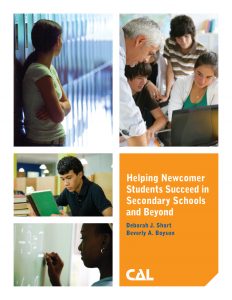Immigrants and Newcomers
 Immigrant Integration
Immigrant Integration
Students from non-English-speaking backgrounds are the fastest growing segment of the K–12 student population in the United States. An increasing number of these students are newcomers—recent arrivals to the United States who have limited or no English language proficiency and who often have had limited formal education in their native countries.
According to the Migration Policy Institute, California and other traditional immigrant-destination states still have the highest numbers of recent arrivals, however, the sharpest growth in these populations are now experienced in states like Nevada, North Carolina, and Georgia. Not only is there an increasing need for immigrant integration, but there is also a demand in geographic areas without a long tradition of welcoming and orienting newcomers.
Several of CAL’s projects and resources are designed to support the implementation of programs for immigrant students. Our work in this area is based on elements that have been shown to build successful newcomer programs. These elements are: parental involvement, developing students’ academic English literacy skills, providing access to the content courses that lead to college and career readiness, and guiding students’ acculturation to U.S. schools and their eventual participation in civic life and the global economy.
Refugee Integration
Every year, thousands of refugees who are fleeing war and persecution are resettled to cities across the United States where they are able to rebuild their lives. Unlike other newcomers to the U.S., refugee integration starts in the country of asylum. First contact and cultural orientation begin before refugees depart for the U.S., and orientation continues as communities are resettled in the USA.
According to the most recent data from the Department of Homeland Security, Bhutan,Burma, and Iraq are the leading countries of nationality for refugee admissions, with 71% of admissions in 2012 being from these countries. On average, refugees are younger than the native-born population. In 2012, thirty-two percent of refugees were younger than 18 years, suggesting that refugee children may have a strong presence in schools in the cities where they are resettled.
CAL has been a leader in refugee education and orientation since 1975, helping refugee newcomers understand fundamental aspects of life in the United States and helping service providers and other interested parties understand the rich cultures and linguistic heritages of the new members of their communities. CAL serves as a national technical assistance provider on both overseas and domestic refugee orientation and on the backgrounds and resettlement needs of new refugee groups. Activities include training; development of print, audiovisual, and web resources; research; dissemination and exchange of information throughout an international network of refugee service providers; and serving as a national clearinghouse of information on refugee orientation and refugee groups.
Services
CAL offers a wide range of professional development and technical assistance services for service providers, schools, and communities working with newcomer populations. Based on our decades of experience, CAL can customize our services to meet your needs and budgets. Email CAL to learn more.
SERVICE SPOTLIGHT: CAL INSTITUTE
Newcomers in Your School: Cultural Connections and Instructional Strategies
Given the increasing tide of newcomer youth entering U.S. schools, it is critical to address the cultural, social, and academic needs of these students and their families. CAL offers professional development that includes practical resources for building a welcoming environment, both socially and instructionally, for all students.
This institute is designed for PreK-12 teachers, administrators, and practitioners, such as social workers, counselors, and after-school specialists, who work in educational settings with newcomer students and their families. CAL encourages teams of educators and practitioners to attend.
Strategies to Strengthen Refugee Orientation and ESL Provision
Given the increasing tide of newcomer youth entering U.S. schools, it is critical to address the cultural, social, and academic needs of these students and their families.
This interactive one-day workshop has been developed to provide practical strategies and resources for maximizing the impact of refugee orientation and English instruction by aligning their content and key messages.
CAL can work with you to customize a workshop or series of workshops to best meet your needs.
Foundations of Dual Language Instruction
This two-day workshop provides dual language educators with research-aligned strategies and hands-on activities that promote bilingualism, biliteracy, and multicultural competence for their emergent bilingual students learning in English and a partner language.
Projects
News and Resources

With the strong and increasing presence of Multilingual Learners in U.S. public schools, multilingual educators are vital to ensuring academic excellence and promoting multilingualism and multiliteracy among these students. However, the current shortage of qualified educators exacerbates the disproportionately small share of those who are multilingual. With a higher percentage of multilingual speakers represented among paraeducators, this group represents a corps of potential teacher candidates. This paper explores the history of exclusionary practices in U.S. education which have influenced current teacher shortages, establishes research on the benefits to diverse students of congruent educators, includes examples of teacher preparation programs which support paraeducator-to-teacher pathways, and explores obstacles faced by multilingual teacher candidates to entering the profession, with proposed processes to eliminate such barriers.

Center for Applied Linguistics
